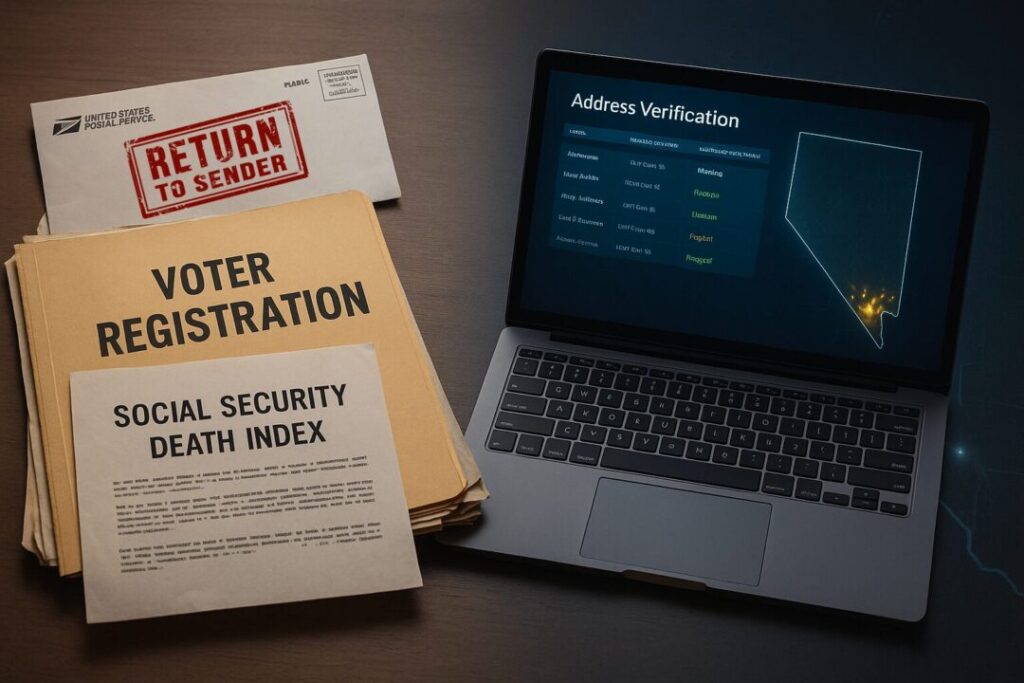For decades, states have relied on two basic tools to clean up voter rolls: the U.S. Postal Service’s change-of-address system, and the Social Security Death Index.
Those worked okay back in 1993, when the National Voter Registration Act was passed. But times have changed.
People move more often now. Sometimes mail is delayed or forwarded incorrectly.
The Death Index may not pick up every recent death. That means someone who’s moved or passed away can still be on the rolls as “active.”
In practice, that leads to strange situations.
In Nevada, a legal group called the Public Interest Legal Foundation (PILF) found addresses on the voter rolls that looked like businesses, casinos, post offices, even tattoo parlors and vacant lots, where it seems very unlikely someone lives.
Also, after the 2024 election, Nevada’s Secretary of State’s office canceled over 162,000 voter registrations and marked nearly 38,000 more as inactive.
That’s a lot of names that needed review.
In Clark County, the Nevada Republican Party claims over 90,000 names that “should no longer be active” were removed in a recent clean-up effort.
These numbers help show how big the issue is: voter rolls aren’t static. They change, and our system hasn’t always kept up.
What Can Be Done? A Better Way
There is a way forward: using commercial data to help manage voter rolls in real time.
Think about how banks or credit lenders check your address when you apply for a loan. They don’t wait for a letter by mail – they pull current data from multiple trusted sources.
That’s something conservative thinkers say election offices could do for voters.
Here’s how it might work:
-
Election offices can use data from address histories, credit records, utility records, and other verified public sources.
-
That data can flag when someone probably moved, or show mixups in names or addresses.
-
If something seems off, election offices send a simple mailer asking the person to confirm or correct their address; if they don’t respond, they might go inactive or be referred for further review.
-
The commercial data moves fast. It doesn’t wait months for returned mail.
This method moves us from reacting to problems, to preventing them.
Fewer ballots go to bad addresses, fewer delays in counting, and less chance of people casting votes they shouldn’t.
This approach is already getting traction. For example:
-
Tarrant County, Texas, now uses a commercial “skip tracing” tool to check if a voter’s address is legitimate.
-
In Orange County, California, local officials used Experian (a credit bureau) to compare voter records to real address changes. Over time, they detected hundreds of thousands of address conflicts.
-
In West Virginia, a pilot project with similar methods found that many registrants had better addresses not yet on the voter roll.
-
A federal study coordinated by the U.S. Election Assistance Commission (EAC) found that feeding 10 % of a state’s roll data to commercial sources led to 7 %–22 % of registrants being matched to more recent addresses – compared to just 2 %–7 % using the Postal Service’s change-of-address data.
These results suggest commercial data tools really can do better.
What Critics Say – And Why They’re Confused
Of course, some worry that “cleaning up” voter rolls could accidentally remove eligible voters.
That is a valid concern. It’s important safeguards are in place so that people aren’t wrongly dropped.
Critics also argue that mass “challenge” processes – where large groups file objections to voter registrations – can be abused and intimidate voters.
They say some of the evidence used in GOP suits (like claims of dead or duplicate voters) is flawed or using bad data.
But from a conservative view, the focus shouldn’t just be on lawsuits or challenges.
It should be on giving election officials better, modern tools that reduce errors before they occur.
That’s less adversarial, more practical.
Also, lawmakers can help.
Congress should require more accountability for federal election-data systems.
States should revise their laws so that commercial data is first in line, and undeliverable mail only a fallback.
That way, cleanup doesn’t rely solely on lawsuits or mass objections.
Nevada’s Voter ID Law Was Step One – This Is Step Two
Nevada is unique. We have a fast-growing, mobile population. Many people move in and out of the state, sometimes within counties.
We also have automatic mail-ballot voting, which means ballots are sent to all active registrants unless they opt out.
If the rolls are dirty, ballots go to bad addresses, or to people no longer living here. That creates more room for confusion or misuse.
We also passed Nevada Question 7 in 2024, a constitutional amendment requiring voter identification for in-person voting (or last four digits of driver’s license / Social Security number for mail ballots).
That change shows the public wants more security in our voting system.
If we combine voter ID with cleaner, up-to-date voter rolls, we strengthen confidence that only those eligible are voting, and that their votes count – and count only once.
In Nevada, the stakes are high. We are a battleground. Every vote matters.
Cleaning voter rolls the modern way is not about blocking anyone from voting. It’s about building a system where voting is easy for eligible citizens, and much harder for error or abuse to sneak through.
For Nevada, this means combining common-sense data tools with transparency and well-written laws. That way, the Silver State can lead in both fairness and security.
The opinions expressed by contributors are their own and do not necessarily represent the views of Nevada News & Views. This article was written with the assistance of AI. Please verify information and consult additional sources as needed.




